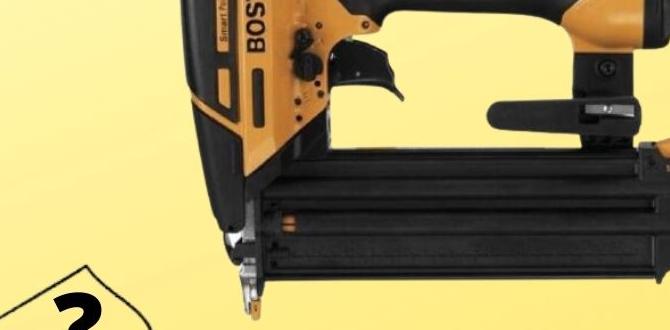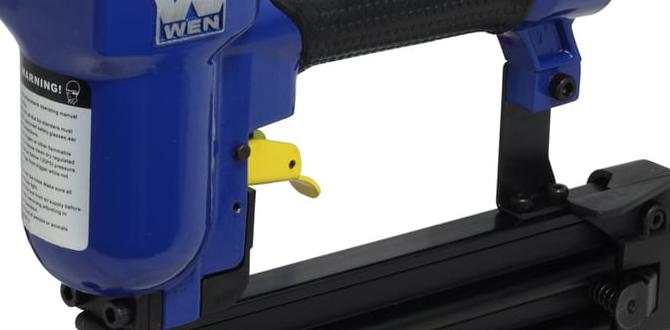Quick Summary: Testing nail strength ensures your DIY projects are secure and long-lasting. Learn simple, effective methods to verify nail holding power, preventing future failures and building confidence in your woodworking skills.
Hey there, DIYer! Jack Shaffer here, your go-to guy for all things nail guns and woodworking. Ever wondered if that nail you just drove is really going to hold up? It’s a common question, especially when you’re building something important, like a deck, a fence, or even just a sturdy shelf. You don’t want to cut corners when it comes to strength. A weak joint can lead to problems down the road, and nobody wants that!
The good news is, testing nail strength doesn’t require fancy equipment or a degree in engineering. With a few simple techniques, you can easily check if your nails are up to the task. We’ll walk through exactly how to do it, so you can feel confident that your projects are built to last. Let’s get those nails tested and your projects built strong!
Table of Contents
Why Testing Nail Strength Matters for Your Projects
When you’re working on a DIY project, the last thing you want is for it to fall apart. Nails are the backbone of many wooden structures, holding pieces together. Understanding how to test their strength is crucial for several reasons:
- Project Longevity: Strong connections mean your projects will stand the test of time, weather, and use.
- Safety: For projects supporting weight or used in high-traffic areas, strength is paramount for safety. Think about a bookshelf that could collapse or a deck railing that could give way.
- Cost-Effectiveness: Fixing failed projects is more expensive than building them right the first time. Testing proactively saves you money and headaches.
- Professional Finish: A well-built, sturdy project looks and feels better, giving you a sense of accomplishment.
- Material Compatibility: Different woods and nail types have varying strengths. Testing helps you understand how they work together.
Whether you’re a seasoned pro or just starting out, these testing methods will give you peace of mind. Let’s dive into how you can easily do this yourself.
Understanding Nail Strength: What Makes a Nail Strong?
Before we test, let’s get a handle on what makes a nail strong. It’s not just about the metal itself, but how it’s made and how it behaves when driven into wood.
Nail Material and Composition
Most common nails are made of steel. The type of steel and any coatings or treatments it receives can affect its strength and corrosion resistance.
- Steel Quality: Higher quality steel generally means a stronger nail.
- Coatings: Some nails have vinyl, cement, or even polymer coatings. These can improve driving ease and holding power, especially in harder woods.
- Galvanization: For outdoor projects, galvanized nails resist rust, which can weaken a nail over time.
Nail Design Features
The shape and features of a nail play a huge role in its holding power:
- Shank: This is the main body of the nail.
- Smooth Shank: The most common, relies purely on friction.
- Ring Shank: Has rings around the shank that grip the wood fibers, offering significantly more holding power.
- Screw Shank (Twisted): Similar to a screw, it twists into the wood, creating a very strong mechanical lock. Excellent for preventing pull-out.
- Head: The top part of the nail. Common types include flat (for general use), finishing (small head, sunk below the surface), or framing (larger head for maximum holding).
- Point: The sharp end. A sharp point drives easier. Some specialized nails have blunt or chisel points to reduce wood splitting
Holding Power vs. Shear Strength
It’s important to distinguish between two key aspects of nail strength:
- Holding Power (Withdrawal Resistance): This is how well the nail resists being pulled straight out of the wood. It’s affected by friction, wood type, and nail design (like ring shanks).
- Shear Strength: This is how well the nail resists bending or breaking under sideways force, like when two pieces of wood are trying to slide past each other. This is mostly dependent on the nail’s material and diameter.
For most DIY projects, we’re most concerned with holding power, as pulling out is a common failure mode. However, shear strength is vital for structural integrity.
Basic Tests You Can Do at Home: No Fancy Tools Needed!
You don’t need a lab to get a good idea of your nails’ performance. Here are some straightforward ways to test them.
1. The “Tap Test” (Qualitative Assessment)
This is your first line of defense and gives you a feel for the nail.
What it tells you: How easily the nail drives and if it bends. Best for new nails you’re about to use.
How to do it:
- Grab a standard hammer and a few nails you intend to use.
- Select a scrap piece of the same wood type you’ll be working with.
- Start hammering a nail into the scrap wood, but don’t drive it all the way in. Leave about half an inch sticking out.
- Pay attention to the resistance. Does it feel too easy? Too hard?
- If the nail bends significantly while driving, it’s likely too soft or brittle for the wood hardness.
- Once hammered in a bit, try to wiggle the nail gently with your fingers. If it feels loose already, it might be too small or the wood is too soft for this nail type.
This test is more about feel and observation. It’s a good way to catch obviously weak or problematic nails before they cause trouble.
2. The Bend Test (Simple Shear Strength Check)
This is a quick way to check for brittleness or weakness in the nail itself.
What it tells you: If the nail is prone to snapping or significantly bending under moderate stress.
How to do it:
- Take a nail and place it on a sturdy, hard surface like a concrete floor or a heavy anvil.
- Using your hammer, strike the head of the nail ONCE with moderate force.
- Observe what happens:
- Ideal: The nail bends slightly without breaking. This shows flexibility.
- Poor: The nail snaps cleanly into two pieces. This indicates the nail is brittle and will likely fail under stress.
- Poor: The nail flattens or deforms excessively without much force. This suggests it’s too soft.
Safety Note: Wear safety glasses! Small metal fragments can fly when a nail breaks.
3. The Pull-Out Test (Holding Power Simulation)
This test gives you a direct measure of how well the nail holds the wood.
What it tells you: The holding power of the nail in a specific wood type.
How to do it:
- Select a piece of scrap wood.
- Drive a nail into the wood. For best results, drive it in about two-thirds of its length, similar to how you might in a real joint. If testing ring-shank or screw-shank nails, drive them fully.
- Let it sit for a few minutes, allowing the wood fibers to “grip” the nail (this is more relevant for coatings or wood expansion).
- Use a pry bar or the claw of your hammer to gently but firmly try to pull the nail out. Lift at the head.
- Observe the resistance. Does it require substantial effort? Is there a loud “creaking” sound as it comes out?
- If the nail pulls out very easily, its holding power might be insufficient for your project’s needs.
For a more precise (but still DIY) approach, you could use a spring scale attached to the nail head and the pry bar to measure the force required to extract the nail. More force means more holding power.
4. The “Wiggle Test” (Friction & Grip Check)
This is a simple, on-the-spot check you can do after driving a nail.
What it tells you: How well the nail is anchored in the wood.
How to do it:
- After driving a nail into your project piece, wrap your fingers (or gloves for safety) around the nail head.
- Gently try to rock the nail back and forth, or twist it slightly.
- If the nail moves or feels loose with minimal effort, it’s not seated securely. This could be due to hammering technique, wood density, or using the wrong nail size.
This is especially useful for drywall screws or finish nails where you want a clean, secure finish without excessive wobble.
Advanced Testing Methods (For More Serious Projects)
If your project is critical or you’re a professional, you might consider more controlled testing. These often involve specialized tools but can provide more quantitative data.
Using a Tensile Strength Tester
A tensile testing machine (or universal testing machine) is a piece of equipment used in labs and manufacturing to determine the tensile strength and stress-strain characteristics of materials. You can buy benchtop models if you’re very serious about DIY testing, but they are expensive.
How it works: The nail is clamped at both ends, and the machine pulls it apart at a controlled rate. It measures the force required to break the nail (tensile strength) and how much it stretches before breaking (elongation).
Relevance for DIY: While you likely won’t buy one, understanding this concept helps appreciate the difference between a cheap, brittle nail and a high-quality, strong one. Manufacturers use these tests extensively.
Impact Testing
Impact testing measures a material’s ability to absorb energy and plastically deform without fracturing. For nails, it assesses their toughness.
How it works: A weighted pendulum (like a Charpy or Izod tester) is swung to strike a notched specimen of the material. The energy absorbed by the material during fracture is measured.
Relevance for DIY: This highlights why some nails might appear to hold well initially but fail suddenly under shock or vibration. High-quality nails are designed to withstand some impact. This is less about “how-to” for a DIYer and more about understanding why certain nails are better for demanding applications.
Factors Influencing Nail Strength in Real-World Applications
The strength of a nail isn’t just an inherent property of the nail itself. How it performs in your project depends heavily on other factors:
Wood Type and Hardness
This is a HUGE factor. Softer woods (like pine) are easier to drive nails into, but nails will have less holding power. Harder woods (like oak or maple) offer more resistance to driving but provide much better holding power. Using a nail that’s too small or too brittle in hardwood can lead to splitting or poor grip.
Here’s a general comparison:
| Wood Type | Typical Driving Difficulty | Holding Power Potential | Nail Considerations |
|---|---|---|---|
| Softwoods (Pine, Fir, Cedar) | Easy | Moderate | Standard nails are usually fine. Consider slightly larger nails or ring-shanks for extra grip. |
| Hardwoods (Oak, Maple, Walnut) | Difficult | High | Pre-drilling pilot holes is often recommended to prevent splitting. Use stronger nails (e.g., thicker shank, hardened steel if driving without pilot holes). |
| Engineered Wood (Plywood, MDF) | Varies, can be prone to splitting | Moderate to High | Be cautious of splitting edges. Use appropriately sized nails or screws. Glue is often a better fastener for MDF. |
Always test your chosen nail on a scrap piece of the exact material you’ll be using for your project.
Nail Size and Gauge
Nails are sold by length (e.g., 2-inch, 3-inch) and by gauge (a number that corresponds to diameter, with lower numbers meaning thicker nails). A thicker nail (lower gauge) will have greater shear strength and can provide better holding power simply due to a larger surface area in contact with the wood.
Driving Technique
How you drive the nail matters:
- Angle: Driving nails at a slight angle (toe-nailing) can significantly increase holding power, as the nail has to bend more to pull out.
- Depth: Driving the nail deep enough is crucial. A nail sticking out too far offers less structural strength. A nail driven too deep and flush can still work, but you might risk damaging the wood surface. For finish nails, you want the head slightly countersunk.
- Straightness: Banged-up nails or nails driven at a severe angle compromise their strength and can damage the wood.
- Nail Gun vs. Hammer: Nail guns offer speed and consistency but can sometimes overdrive or underdrive nails if not set correctly. Hammers require more skill but allow for more tactile feedback.
For critical structural connections, consider using screw fasteners, which generally offer superior holding power and are less prone to pull-out. Many building codes require screws or specialized structural connectors for certain applications. You can find information on building codes and fastener requirements from resources like the International Code Council (ICC).
Environmental Factors
- Moisture: Wood expands and contracts with humidity changes. This can put stress on nails, potentially loosening them over time.
- Corrosion: Rust weakens nails significantly, especially over long periods. If your project is exposed to the elements, use corrosion-resistant nails (e.g., stainless steel, hot-dip galvanized).
- Load Type: Is the load static (like a cabinet) or dynamic (like a gate that opens and closes)? Dynamic loads put more stress on fasteners.
Troubleshooting Common Nail Strength Issues
Even with testing, you might encounter problems. Here’s how to address them:
- Nails Bending or Breaking:
- Cause: Nail is too brittle, wood is too hard, not pre-drilling, improper hammer strike.
- Fix: Use a higher quality nail (check the material and gauge). Pre-drill pilot holes in hardwood. Ensure you’re using the correct hammer weight and striking squarely. For nail guns, ensure the pressure is set appropriately for the wood density.
- Nails Pulling Out Easily:
- Cause: Wood is too soft, nail is too smooth shank, insufficient depth, joint is under constant stress.
- Fix: Use ring-shank or screw-shank nails for better grip. Use longer nails to get into denser wood below the surface. Ensure you’re driving nails to adequate depth. Consider using glue in addition to nails for maximum strength. For very high-stress applications, switch to screws.
- Wood Splitting When Nailing:
- Cause: Nailing too close to the edge of the wood, using too thick a nail for the wood.
- Fix: Pre-drill pilot holes, especially in hardwoods or near edges. Use a thinner gauge nail. Hammer nails slightly further from the edge. Use blunter-pointed nails or special “no-split” nails if available.
- Joints Seem Loose After Nailing:
- Cause: Nails were underdriven, nails have backed out slightly, wood movement.
- Fix: Ensure nails are driven to the correct depth. Use the wiggle test immediately after driving. If loose, consider reinforcing the joint with additional fasteners or glue, or even replacing the failed nails with stronger screws. Keeping fasteners away from the surface and ensuring they penetrate sufficiently into the main structural member helps.
FAQs About Testing Nail Strength
Q1: How do I know what kind of nail to use for my project?
Consider the wood type (hardwood vs. softwood), the thickness of the material, and the expected load. For general-purpose projects, standard smooth-shank nails are fine. For holding power, especially in situations with vibration or pulling forces, ring-shank or screw-shank nails are better. For outdoor use, always opt for galvanized or stainless steel.



